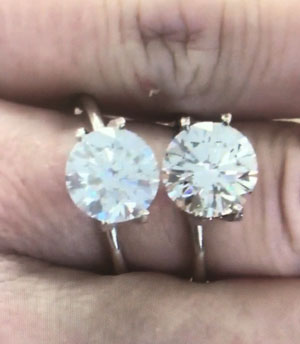Touch, Feel, See…Buy
When you are about to make a purchase as important as a diamond, especially THE diamond (if you know what I mean), there is nothing more important than the tactile feel of handling your stone. By interacting with the stone, you can see the brilliance, the fire and the look of the cut.
When shopping for a diamond, it is important to keep in mind the four C’s: color, clarity, cut and carat weight. Of the four C’s, one of the most important aspects is cut. Ideal cut diamonds are cut to specific dimensions that produce exceptional brilliance. An ideal cut is considered “absolute perfection” in polish, symmetry and cut. Jewelers use ratings from good to excellent (sometimes referred to as “X” or “EX”), to grade diamonds. When a stone is rated as “triple excellent”, it is excellent for polish, symmetry and cut.
The simplicity of shopping on the internet has become a consumer favorite, but not all purchases are created equal. For example, a sweater may look great online and when it arrives, it looks pretty much like it did online. However, this isn’t always the case with diamonds.
To begin, the purchase of a diamond is a big ticket item; you want to ensure that what you see is really what you wanted, and most importantly, what you get. By seeing your diamond in person, you can roll it around and see the characteristics of it. This is important. You cannot do that online. Even with the presence of great 3D/HD video, the sale is still missing the importance of physical interaction. Each diamond can have internal characteristics; graining, naturals, feathers, clouds and possibly fluorescence. Too much of any of those characteristics can make the diamond misty or cloudy, greatly diminishing the clarity of the stone and the brilliance to the naked eye. Sometimes, that misty or cloudy appearance is not readily apparent at certain angles. When handling your stone in person you have control of looking at the stone from all angles. Additionally, you may have the advantage to look into the stone at a deeper level by looking into a microscope or under a jeweler’s loupe. Most natural diamonds have varying characteristics, as mentioned above. Similar to an individual’s fingerprint, these characteristics make the stone unique and help identify the diamond on a certification, but viewing the diamond in person is integral to ensuring your purchase is of value.

Here is an internet shopper comparison. This milky stone was advertised as a 2ct SI1 (slightly included), H (color) XXX GIA (polish, symmetry, and cut), no fluorescence. However, in the "comments" section it stated: "internal graining and clouds". It is sitting next to a diamond that is rated exactly the same, without those additional characteristics listed in the comments.
When comparing two similar diamonds on paper (meaning measuring the statistics of the details of each of the diamonds), one might use only those measurements listed in cut, color, clarity, and carat weight or be misled by claims like a stone being free of fluorescence. This leads shoppers into thinking they had an “aha bargain” moment. However, the devil is in the details, or in this case, "the comments", especially when the word "graining" or "clouds" are mentioned.
It is important to note, graining, clouds, or fluorescence should never, never, never be considered unacceptable. When dealing with a stone with fluorescence, it doesn’t mean that the stone is destined to be cloudy. Occasional fluorescence is a natural occurrence. This is a perfect example of why you have to see the diamond "live" when shopping. Simply stated, diamonds that jewelers reject find their way somewhere else. All you have to do is click your mouse. Please take the time to reliably check your diamond purchase. You want to be proud to wear and pass on a generational diamond. After all, diamonds are forever…





